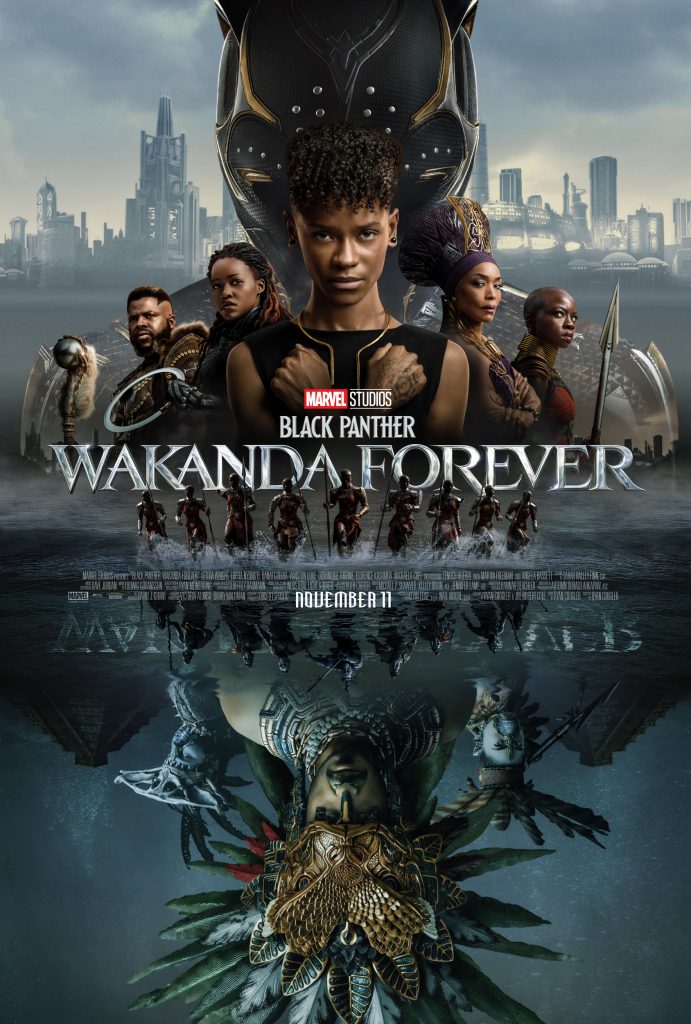“Black Panther: Wakanda Forever,” the sequel to 2018’s cultural phenomenon “Black Panther,” finally hit theaters on Nov. 11, concluding Phase Four of the Marvel Cinematic Universe (MCU). The film had a lot to live up to following the tragic death of the “Black Panther” actor, Chadwick Boseman, in 2020. Rather than recast him, the film opts to mourn him and his character, studying his family as they grieve and try to live in a world without their beloved king.
Although Boseman was unable to reprise his role as Wakandan King, T’Challa, the film features the return of Letitia Wright as his sister, Shuri, and Angela Bassett as his mother, Queen Ramonda, among many others. It also introduces Tenoch Huerta as the villainous mutant, Namor. “Black Panther” director Ryan Coogler also returned to write and direct the film.
One of the movie’s highlights is certainly how it handles death and the grieving process with respect to T’Challa. The opening scene of the film makes it very clear that this is a film about death as Shuri is unable to save her brother’s life. Shuri and Ramonda handle their grief in very different ways, as Ramonda accepts her son’s death while Shuri turns her pain into anger and shuts herself off from the world. The audience is able to grieve both T’Challa and Boseman along with the characters in the film.
Likewise, the visual effects of the film are absolutely stunning. The shots of Wakanda are beautiful yet empty. The audience can sense that something has been taken from the kingdom too soon. A large portion of the film is also spent in Talokan, an underwater nation run by Namor. The scenery of Talokan matches the majesty of Wakanda and sets it up as a worthy rival nation.
“Black Panther: Wakanda Forever” is hit or miss with its use of cameos from other characters in the MCU. Perhaps the best scene in the film features the return of Michael B. Jordan’s, Killmonger, as he gives Shuri advice from the ancestral plane. However, the rest of the cameos are not so impactful. Both Martin Freeman and Julia Louis-Dreyfus reprise their roles as CIA operatives from previous MCU projects, but they easily could be cut from the story and it would not change the film at all.
Similarly, Coogler makes some technical choices that sometimes work and sometimes do not. There are multiple moments played in slow motion, which are effective in highlighting the importance and gravity of these scenes. On the other hand, there is a repetition of shots with the second time playing in reverse, creating a confusing bridge between the beginning and end of the film. There is also an annoyingly edited scene between Freeman and Louis-Dreyfus where it was clear they were not in the same room when the scene was filmed.
Unfortunately, “Black Panther: Wakanda Forever’’ sorely misses the defining lead performances from Boseman and Jordan that defined the first “Black Panther.” Wright does her best as the lead of the film, but she lacks the charisma needed to carry an entire Marvel film on her back. Similarly, Huerta gives a strong performance as Namor, but ultimately feels like a discount version of Killmonger as both villains have essentially the same backstory of wanting revenge for their ancestors’ enslavement, but Killmonger was more ruthless as an enemy to Wakanda.
The ending of the film also leaves a lot to be desired. Although the first two-thirds expertly navigate grieving characters in their quest for understanding, the final act of the film turns into a big mindless battle between the Wakandans and the people of Talokan. While this is not necessarily a bad thing, as almost every single MCU film does this, it feels cheap and hypocritical for what was a dramatic film about the grieving process to turn into a big CGI fight where many people die with no afterthought.
It is particularly frustrating to watch one of cinema’s most overused tropes, the death fake-out, be present in this film. Although almost every modern action film will have a moment where the hero survives something they should not, it feels especially jarring here because it lessens the impact and meaning of the characters who die. Unfortunately, this tonal inconsistency holds the film back from greatness as it cannot decide whether it is a melodrama about grief or a superhero film. Coogler tried to have his cake and eat it too, which is unfortunate because the ending of the film severely undermines the core themes established early on.
Overall, “Black Panther: Wakanda Forever” is a difficult film to watch, for both good and bad reasons. It is difficult to watch beloved characters struggle with the loss of a king gone too soon and while that pain works, it is equally frustrating to watch the film throw it all away just to end like every other superhero film. This could have been the first MCU film to really break the mold and be something greater, but unfortunately, it falls victim to the pitfalls that have made the franchise go stale in recent years.
Rating: 2.5 out of 5 stars



